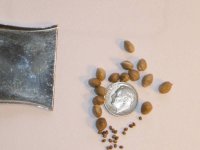This was a wild landrace variety I collected 9000 feet in Kashmir, the THC is very low and the seeds sprout very easy, seed production is very easy, seed harvest and collection is very hard as when you touch the plants the slightest the mature seeds seem to be spring loaded and are propelled from the plant. I collected the seeds very carefully with an upside down umbrella with a slit to allow the umbrella under the plant, that worked fairly good.
I suspect they are so easily shattering because they are very wild and man has not bred them or selected them for what man wants, bigger seeds and non shattering seeds in the flowers.
I did grow them at sea level in Santa Cruz to see if the would effect seeds size, it did not they were just as small.
-SamS
I suspect they are so easily shattering because they are very wild and man has not bred them or selected them for what man wants, bigger seeds and non shattering seeds in the flowers.
I did grow them at sea level in Santa Cruz to see if the would effect seeds size, it did not they were just as small.
-SamS
Attachments
Last edited:




